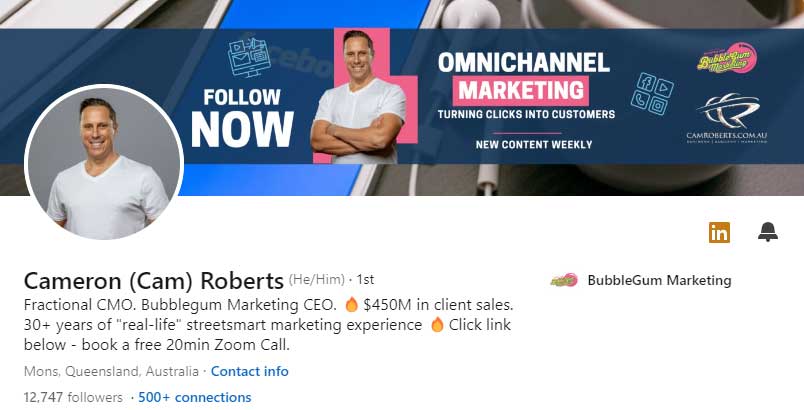How Retargeting Ads Can Increase Conversions by 70
By Cameron Roberts – Founder & CEO of Bubblegum Marketing,
Posted On March 24, 2025
By using targeted ads, businesses can remind these potential customers of what they’re missing, significantly boosting conversion rates. Retargeting ads can boost conversions by up to 70%. Let’s take a closer look at how they work and why they are important for your marketing plan.

What Are Retargeting Ads?
Retargeting ads are a form of online advertising that targets users who have previously interacted with your website or mobile app. Unlike regular display ads that target a broad audience, retargeting ads focus on individuals who have already shown interest in your products or services.
Understanding the Mechanism
These ads work by using cookies or pixels to track visitors. When someone visits your site, a small piece of code (known as a pixel) is placed in their browser. This pixel tracks their activity across the web, allowing your ads to “follow” them as they navigate to other sites. This advanced targeting mechanism ensures that your ads are seen by those who are already familiar with your brand, increasing the chances of conversion.
The Role of Cookies and Pixels
Cookies and pixels play a crucial role in retargeting. Cookies are small text files stored in a user’s browser, while pixels are transparent images embedded in web pages. Both tools collect data on user behavior, enabling businesses to create personalized ad experiences. Understanding how these tools work can help you optimize your retargeting strategy for better results.
Differentiating from Regular Ads
Unlike regular ads that cast a wide net to attract new customers, retargeting ads focus on warming up leads that have already interacted with your brand. This distinction makes them more efficient in converting interested users into paying customers. By honing in on a specific audience, retargeting ensures that your marketing efforts are not wasted on those who may never engage with your brand.
Types of Retargeting Ads
There are several types of retargeting ads, each serving a specific purpose. Here are the most common ones:
1. Pixel-Based Retargeting
Pixel-based retargeting is the most common form of retargeting. It involves placing a small piece of JavaScript (a pixel) on your website. This pixel tracks your visitors and allows you to serve ads to them as they browse other sites.
How Pixel-Based Retargeting Works
When a visitor lands on your website, the pixel activates and starts collecting data on their browsing behavior. This data is then used to display relevant ads to the user as they continue to surf the web. By using this method, businesses can effectively remind users of their initial interest and encourage them to return.
Benefits of Pixel-Based Retargeting
This method offers several benefits, including real-time tracking and immediate ad deployment. It allows businesses to target users shortly after their initial visit, keeping your brand fresh in their minds. The immediacy of pixel-based retargeting can lead to higher engagement and conversion rates.
Best Practices for Implementation
To implement pixel-based retargeting effectively, ensure that your pixel is correctly placed on every page of your website. Regularly test and update your pixel to ensure it collects accurate data. Additionally, consider segmenting your audience based on their on-site behavior to deliver more personalized ads.

2. List-Based Retargeting
List-based retargeting uses a list of email addresses from your existing database. This method works by uploading the list to a retargeting platform, which then matches the email addresses with users on the platform. Ads are then served to these users as they browse the web.
Gathering and Utilizing Email Lists
The success of list-based retargeting hinges on the quality of your email list. Gather emails through sign-ups, subscriptions, and customer accounts. Once you have a robust list, you can upload it to platforms like Facebook Ads to start targeting those users specifically or you can contact facebook ads agency.
Advantages of List-Based Retargeting
This method is advantageous because it targets users who have already shown a willingness to engage with your brand by providing their email. It allows for highly personalized ad content and can be used to promote specific offers or messages to a select group of users.
Challenges and Solutions
One challenge with list-based retargeting is maintaining an up-to-date and accurate email list. Regularly clean your list to remove inactive or incorrect addresses. Additionally, ensure compliance with data privacy regulations to avoid any legal issues.
3. Search Retargeting
Search retargeting targets users based on their search behavior. This involves showing ads to users who have searched for specific keywords related to your products or services, even if they haven’t visited your website.
How Search Retargeting Differs
Unlike other forms of retargeting that focus on past interactions with your site, search retargeting targets users based on their search queries. This approach allows you to reach potential customers who are actively seeking products or services similar to yours.
Crafting Effective Search Retargeting Campaigns
To create an effective search retargeting campaign, start by identifying the keywords that potential customers are likely to search for. Use these keywords to craft targeted ads that address the user’s needs or interests. Continuously refine your keyword list based on performance data.
Maximizing Reach and Engagement
Search retargeting can significantly expand your reach by targeting users who have shown intent through their search activities. By delivering relevant ads to these users, you can engage them at a critical point in their decision-making process, increasing the likelihood of conversion.
4. Social Media Retargeting
Social media retargeting involves serving ads to users on social media platforms like Facebook, Instagram, and Twitter. These platforms provide robust targeting options, allowing you to reach users based on their interests, behaviors, and demographics.
Utilizing Social Media Platforms
Social media platforms offer unique opportunities for retargeting due to their vast user bases and advanced targeting capabilities. By leveraging these platforms, you can reach users in a space where they spend a significant amount of their time.
Creating Engaging Social Media Ads
To succeed with social media retargeting, focus on creating visually appealing ads that capture attention. Use eye-catching images or videos, accompanied by compelling copy and a strong call-to-action. Tailor your content to the platform to ensure it resonates with the audience.
Measuring and Optimizing Performance
Monitor the performance of your social media retargeting ads closely. Use analytics tools provided by the platforms to track engagement metrics such as likes, shares, and click-through rates. Use this data to optimize your campaigns and improve their effectiveness.

Why Retargeting Ads Are Effective
Retargeting ads are highly effective for several reasons:
Increased Brand Recall
Retargeting ads help reinforce your brand in the minds of potential customers. By consistently appearing in front of users who have already shown interest, you keep your brand top-of-mind, increasing the likelihood of conversion.
The Psychology of Repetition
Repetition is a powerful tool in marketing psychology. By repeatedly exposing users to your brand, you create familiarity and build trust. This repeated exposure can make users more likely to choose your brand when they are ready to make a purchase.
Strategies for Building Brand Recall
To enhance brand recall, focus on delivering consistent messaging across all your retargeting ads. Use your brand’s colors, logo, and voice consistently to strengthen recognition. Additionally, consider using storytelling techniques to create memorable ad experiences.
Measuring Brand Recall Success
While brand recall can be challenging to quantify, track metrics like ad impressions and brand searches to gauge effectiveness. Surveys and customer feedback can also provide insights into how well your brand is remembered by your audience.
Higher Conversion Rates
Retargeting ads are specifically designed to target individuals who have already expressed interest in your products or services. This focused approach leads to higher conversion rates compared to traditional display ads, which target a broader audience.
Understanding Conversion Rate Optimization
Conversion rate optimization involves fine-tuning your retargeting ads to maximize the number of users who take the desired action. This can include making a purchase, signing up for a newsletter, or downloading a resource.
Techniques for Boosting Conversion Rates
Use personalized ad content that speaks directly to the user’s previous interactions with your brand. Highlight unique selling points or offer incentives to encourage conversions. A/B testing different ad variations can also help identify the most effective strategies.
Analyzing Conversion Data
Regularly analyze conversion data to identify trends and areas for improvement. Look at metrics such as conversion rates, cost per conversion, and customer lifetime value. Use this data to refine your campaigns and achieve better results.
Improved ROI
Because retargeting ads have higher conversion rates, they typically offer a better return on investment (ROI) compared to other forms of online advertising. By investing in retargeting, you can make the most of your marketing budget by reaching users who are more likely to convert.
Calculating ROI for Retargeting Campaigns
To calculate ROI, compare the revenue generated from your retargeting ads to the costs incurred. This includes ad spend, creative development, and management fees. A positive ROI indicates that your campaign is effectively driving revenue.
Strategies for Maximizing ROI
Focus on targeting high-intent users who are most likely to convert. Use cost-effective ad formats and optimize your bidding strategy to get the best results. Continuously test and refine your campaigns to maximize your return on investment.
Long-Term Benefits of Retargeting
In addition to immediate ROI, retargeting can offer long-term benefits by nurturing customer relationships and encouraging repeat purchases. Satisfied customers are more likely to become brand advocates, further enhancing your ROI over time.
Personalized Advertising
Retargeting ads allow for a high degree of personalization. You can tailor your ads based on the specific products or services a user viewed on your site, making your ads more relevant and engaging.
The Power of Personalization
Personalization is a key driver of engagement and conversion. By delivering ads that speak directly to the user’s interests and needs, you create a more meaningful connection with your audience.
Techniques for Personalizing Ads
Use dynamic ad content that automatically updates based on the user’s behavior and preferences. Incorporate personalized messaging that addresses the user’s pain points or desires. Consider using retargeting to offer personalized promotions or recommendations.
Balancing Personalization with Privacy
While personalization can enhance ad effectiveness, it’s important to respect user privacy. Ensure compliance with privacy regulations and provide clear options for users to manage their data preferences. Transparency builds trust and enhances the effectiveness of personalized advertising.

How to Implement a Successful Retargeting Campaign
Implementing a successful retargeting campaign requires careful planning and execution. Here are some steps to help you get started:
1. Set Clear Goals
Before launching a retargeting campaign, it’s important to set clear goals. Determine what you want to achieve with your campaign, whether it’s increasing website traffic, boosting sales, or improving brand awareness.
Defining Campaign Objectives
Start by outlining specific, measurable, achievable, relevant, and time-bound (SMART) objectives for your retargeting campaign. Clear goals provide direction and a basis for measuring success.
Aligning Goals with Business Strategy
Ensure that your retargeting goals align with your broader business strategy. Consider how your campaign can support overall marketing objectives and contribute to long-term growth.
Setting Benchmarks for Success
Establish benchmarks for key performance indicators (KPIs) such as click-through rates, conversion rates, and return on ad spend (ROAS). Use these benchmarks to evaluate campaign performance and make data-driven decisions.
2. Segment Your Audience
Segmenting your audience allows you to create more targeted and relevant ads. Consider segmenting based on factors such as the pages a user visited, the products they viewed, or the time they spent on your site.
The Importance of Audience Segmentation
Segmentation enables you to deliver personalized ad experiences to different groups within your audience. By understanding the unique needs and behaviors of each segment, you can create more compelling and relevant ads.
Methods for Effective Segmentation
Use data analytics to identify meaningful segments within your audience. Consider factors such as demographics, behavior, and purchase history. Create tailored ad content for each segment to maximize engagement and conversions.
Tools for Audience Segmentation
Leverage tools like Google Analytics, Facebook Audience Insights, and CRM systems to gather data and create detailed audience segments. These tools can help you understand your audience better and refine your targeting strategy.

3. Create Compelling Ad Content
Your retargeting ads should be visually appealing and include a strong call-to-action (CTA). Consider using dynamic ads that automatically display the products a user viewed on your site.
Crafting Engaging Visuals
Visuals play a critical role in capturing attention and conveying your message. Use high-quality images or videos that reflect your brand’s identity and resonate with your audience. Test different visuals to determine what works best for your target segments.
Writing Persuasive Copy
The copy in your ads should be clear, concise, and compelling. Highlight the benefits of your products or services and include a strong CTA that encourages users to take the desired action. Use persuasive language that speaks directly to the user’s needs or desires.
Utilizing Dynamic Ad Features
Dynamic ads allow for greater personalization by automatically displaying relevant products or services to each user. This feature enhances the relevance of your ads, making them more likely to engage users and drive conversions.
4. Choose the Right Platforms
Select the platforms where you want to display your retargeting ads. Popular options include Google Ads, Facebook, and Instagram. Consider where your target audience is most active and allocate your budget accordingly.
Evaluating Platform Options
Each advertising platform offers unique features and audience demographics. Evaluate the strengths and weaknesses of each platform to determine which ones align best with your campaign goals and target audience.
Aligning Platforms with Audience Behavior
Consider where your audience spends their time online and choose platforms that reach them effectively. For example, if your target audience is active on social media, platforms like Facebook and Instagram may be ideal for your retargeting efforts.
Budget Allocation Strategies
Distribute your budget across platforms based on their potential to deliver the highest return on investment. Regularly review performance data to adjust your budget allocation and ensure your spending aligns with campaign objectives.
5. Monitor and Optimize Your Campaign
Once your campaign is live, monitor its performance closely. Use analytics to track key metrics such as click-through rates (CTR), conversion rates, and ROI. Use this data to optimize your campaign and make necessary adjustments.
Tracking Campaign Performance
Use analytics tools to gather data on how your retargeting ads are performing. Track metrics such as impressions, clicks, conversions, and cost per acquisition (CPA) to evaluate the effectiveness of your campaign.
Identifying Areas for Improvement
Regularly review performance data to identify areas where your campaign may be underperforming. Look for patterns or trends that can provide insights into what is working and what needs improvement.
Implementing Optimization Strategies
Based on your analysis, implement optimization strategies to enhance campaign performance. This may include testing new ad creatives, adjusting bidding strategies, or refining audience segments. Continuously experiment and iterate to achieve the best results.
Challenges and Considerations
While retargeting ads are highly effective, there are some challenges and considerations to keep in mind:
Ad Fatigue
Showing the same ads repeatedly can lead to ad fatigue, where users become annoyed and start ignoring your ads. To combat this, regularly update your ad creatives and limit the frequency of your ads.
Recognizing the Signs of Ad Fatigue
Ad fatigue occurs when users become desensitized to your ads due to overexposure. Signs include declining click-through rates and engagement metrics. Recognizing these signs early can help you take corrective action.
Refreshing Ad Creatives
To prevent ad fatigue, regularly update your ad creatives with fresh visuals, copy, and offers. Use A/B testing to identify which elements resonate most with your audience and incorporate those insights into your new creatives.
Managing Ad Frequency
Set frequency caps to limit the number of times a user sees your ads within a specific time frame. This helps prevent overexposure and ensures your ads remain effective over time.

Privacy Concerns
Retargeting involves tracking user behavior, which can raise privacy concerns. Ensure you comply with privacy regulations such as GDPR and CCPA by providing clear privacy notices and allowing users to opt out of tracking.
Understanding Privacy Regulations
Familiarize yourself with relevant privacy regulations such as the General Data Protection Regulation (GDPR) and the California Consumer Privacy Act (CCPA). These laws govern how businesses can collect and use consumer data.
Implementing Privacy Best Practices
Ensure transparency by providing clear privacy notices and obtaining user consent for data collection. Offer options for users to manage their data preferences and opt out of tracking if desired.
Building Trust with Users
Respecting user privacy builds trust and enhances the effectiveness of your retargeting efforts. By prioritizing transparency and consent, you can create positive user experiences that drive long-term success.
Budget Management
Retargeting ads can be cost-effective, but it’s important to manage your budget carefully. Set a budget that aligns with your goals and monitor your spending to ensure you’re getting the best ROI.
Setting a Realistic Budget
Determine a realistic budget for your retargeting campaign based on your goals and available resources. Consider factors such as ad spend, creative development, and platform fees when setting your budget.
Monitoring Spending and Performance
Regularly review your spending and performance data to ensure your budget is being used effectively. Use analytics tools to track key metrics and identify areas where you can optimize your spending.
Adjusting Budget Allocation
Be prepared to adjust your budget allocation based on campaign performance. If certain platforms or segments are delivering higher ROI, consider reallocating your budget to maximize results.
📸 Get daily marketing inspiration! Follow me on Instagram for expert tips, behind-the-scenes insights, and proven strategies to grow your business.
Conclusion
Retargeting ads are a powerful tool for increasing conversions and maximizing your marketing budget. By targeting individuals who have already shown interest in your products or services, you can boost brand recall, improve conversion rates, and achieve a higher ROI.
By following best practices and continuously optimizing your campaigns, you can harness the full potential of retargeting ads and drive significant growth for your business. So, if you haven’t already, it’s time to incorporate retargeting ads into your marketing strategy and start seeing results.
Taking Action
Now that you understand the benefits and strategies for retargeting, it’s time to take action. Start by setting clear goals and planning your campaign strategy. Implement the steps outlined in this guide to create effective retargeting campaigns that drive results.
Continuous Learning and Adaptation
The digital advertising landscape is constantly evolving, so stay informed about new trends and technologies in retargeting. Continuously learn and adapt your strategies to stay ahead of the competition and achieve your marketing goals.
Embracing the Power of Retargeting
With the right approach, retargeting can become a cornerstone of your marketing strategy. Embrace its potential to connect with your audience, improve conversion rates, and drive business growth. Start your retargeting journey today and unlock the full benefits of this powerful advertising tool.
WANT TO BE OUR NEXT SUCCESS STORY?
Book a Free Consult
Schedule a 15-minute Free Consultation via Zoom meetings with our Director, Cam Roberts by clicking the button below now:
Recent Articles
- Why Your Email Click Rates Look Low in 2025
- How Our eCommerce Marketing Agency Drove 121% Growth
- What Is Google BARD? A Guide to Google’s New AI
- Facebook Ads Budgeting & Strategies for 2025
- Top Marketing Strategies from Fortune 500 Companies
- Weird & Wonderful: Things Google Probably Doesn’t Want You to Know
- Top 7 Mistakes Businesses Make Without a Facebook Ads Specialist
- Why Automated Sales Funnels Are a Game-Changer for Small Businesses
- How to Choose the Right Facebook Ads Agency in 2025
- Social Media Advertising Trends 2025 for Business Growth
Request A Quote
Request A Quote for your next Website or Funnel Project below:










































